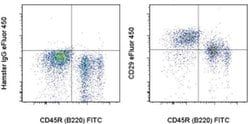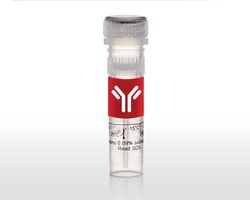CD29 (Integrin beta 1) Monoclonal Antibody (eBioHMb1-1 (HMb1-1)), eFluor™ 450, eBioscience™, Invitrogen™
Manufacturer: Fischer Scientific
Select a Size
| Pack Size | SKU | Availability | Price |
|---|---|---|---|
| Each of 1 | 50-255-0812-Each-of-1 | In Stock | ₹ 34,888.00 |
50-255-0812 - Each of 1
In Stock
Quantity
1
Base Price: ₹ 34,888.00
GST (18%): ₹ 6,279.84
Total Price: ₹ 41,167.84
Antigen
CD29 (Integrin beta 1)
Classification
Monoclonal
Concentration
0.2 mg/mL
Formulation
PBS with 0.09% sodium azide, pH 7.2
Gene Accession No.
P09055, P49134
Gene Symbols
ITGB1
Purification Method
Affinity chromatography
Regulatory Status
RUO
Gene ID (Entrez)
16412, 24511
Content And Storage
4°, C, store in dark, DO NOT FREEZE!
Form
Liquid
Applications
Flow Cytometry
Clone
eBioHMb1-1 (HMb1-1)
Conjugate
eFluor 450
Gene
ITGB1
Gene Alias
4633401G24Rik; AA409975; AA960159; Beta OL; beta oligodendroglia; CD29; CSAT antigen; ENSMUSG00000051907; Fibronectin receptor subunit beta; FNRB; Glycoprotein IIa; Gm9863; gpIIa; integrin beta 1; integrin beta 1 (fibronectin receptor beta); integrin beta 1A precursor; Integrin beta1; integrin beta-1; integrin beta-1 subunit; integrin beta1D; integrin precursor; integrin subunit beta 1; integrin VLA-4 beta subunit; integrin VLA-4 subunit beta; integrin, beta 1; integrin, beta 1 (fibronectin receptor, beta polypeptide, antigen CD29 includes MDF2, MSK12); ITBG1D; ITGB1; JG22 antigen; MDF2; MSK12; RGD-receptor; very late activation protein, beta polypeptide; VLA-4 subunit beta; VLAB; VLA-BETA
Host Species
Armenian Hamster
Quantity
100μg
Primary or Secondary
Primary
Target Species
Mouse, Rat
Product Type
Antibody
Isotype
IgG
Description
- Description: The eBioHMb1-1 monoclonal antibody reacts with mouse and rat CD29 (integrin beta 1), a 110-120 kDa member of the beta integrin family expressed by leukocytes, endothelial, smooth muscle and epithelial cells
- CD29 binds non-covalently with the alpha integrins CD49a-f to form the VLA-1 through VLA-6 complexes, as well as with CD51
- These alpha-beta integrin heterodimers are capable of mediating a variety of cellular responses including adhesion, trafficking, proliferaton and differentiation
- All integrins which include CD29 bind to extracellular matrix proteins including collagen, laminin, fibronectin and vitronectin, whereas some CD29-containing integrins can also interact with cellular receptors such as VCAM-1 and MadCAM-1
- Applications Reported: This eBioHMb1-1 (HMb1-1) antibody has been reported for use in flow cytometric analysis
- Applications Tested: This eBioHMb1-1 (HMb1-1) antibody has been tested by flow cytometric analysis of mouse bone marrow cells
- This can be used at less than or equal to 1 μg per test
- A test is defined as the amount (μg) of antibody that will stain a cell sample in a final volume of 100 μL
- Cell number should be determined empirically but can range from 10^5 to 10^8 cells/test
- It is recommended that the antibody be carefully titrated for optimal performance in the assay of interest
- eFluor™ 450 is an alternative to Pacific Blue™
- ITGB1 (Integrin Subunit Beta 1, beta1 integrin subunit, GPIIa, CD29) is a 110 kDa cell surface glycoprotein that is widely expressed by a variety of cells including all leucocytes
- ITGB1 forms non-covalently linked heterodimers with at least 6 different alpha chains (alpha1-alpha6, CDa-f) determining the binding properties of beta1 (VLA) integrins
- ITGB1 is a cell adhesion molecule appearing on platelets, as the common Beta subunit of the very late activation antigen (VLA), and as a component of various protein complexes binding to extracellular matrix proteins
- Decreased expression of ITGB1 correlates with acquiring multidrug resistance of tumor cells in the presence of anti-tumor drug
- ITGB1 is up-regulated in leukocytes during emigration and extravascular migration and appear to be critically involved in regulating the immune cell trafficking from blood to tissue
- Further, ITGB1 also regulates tissue damage and disease symptoms related to inflammatory bowel disease
- Through an ITGB1-dependent mechanism, fibronectin and type I collagen enhance cytokine secretion of human airway smooth muscle in response to IL-1beta
- More than 8 beta subunits with numerous splice variant isoforms have been identified in mammals
- There are two major forms of integrin beta1: beta1A and beta1D, which differ in 13 amino acids
- The distribution pattern in adult tissues for integrin beta types are mutually exclusive
- Beta1A is present in all tissues, except cardiac and skeletal muscle which express the beta1D variant.



